Every year, the WMS hosts an exciting wilderness medicine elective for residents and medical students. This article will focus on the resident portion. Whereas previously the elective took place at a single wilderness location, the structure of the resident elective was changed this year to an expedition-based model that included three different locations. The first was Smith Mountain Lake in Virginia, the second Cannan Valley in West Virginia, and the third location was near Pilot Mountain, North Carolina. At each location, three meals a day were provided, and housing was provided in rental homes. Residents from all over the country and varying specialties participated in the elective. Simulation and didactic lectures were provided to teach about various wilderness medicine topics and scenarios. The learning environments included ski resorts and natural snow areas, caves, rivers and whitewater rapids, trails, and vertical climbing environments, including rock walls. This elective provides valuable exposure to the world of wilderness medicine in addition to FAWM credits.
The elective began when residents arrived in Virginia. Initial topics covered patient assessments and patient movements. This included our first exposure on how to properly set up litters and transport patients. The night ended with a jeopardy orthopedic injury review. The next day included an ultrasound workshop and lectures on hemorrhage control and anaphylaxis. We then practiced patient extrications and hyperthermia scenarios. The night ended with a discussion of psychiatric topics in wilderness medicine.
The second day included whitewater rafting and discussions about drownings and water safety. After paddling down the river, we stopped at a waterfall and practiced a patient extrication scenario that involved a litter carry through a creek, around boulders, and over rocky terrain. We ended that scenario with a discussion regarding drownings and then continued downstream to the takeout area. After breaking down the rafts, we returned to Roanoke and had dinner and reviewed ophthalmologic emergencies.
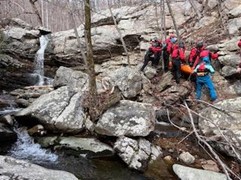
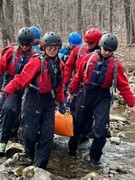
Simulating a patient rescue and extrication. (Photographer: Dr. Stephanie Lareau)
The next day was a thrilling caving trip. We started the day with discussions regarding concussions and marine envenomation before heading to the caving area. After a short hike, we arrived at the entrance to the cave, prepared our gear and headlamps, and began the journey through the cave. We spent five hours crawling through various paths and learned how to navigate a cave system, discussing scenarios that would involve patient extrications from caves and various medical conditions that could affect people while they navigate caves. We then headed out for a nice dinner in Roanoke and ice cream. Our final day in Virginia involved learning about dive medicine as well as diabetic emergencies and treatments in the wilderness. We were treated to a boat tour around the lake that included close views of Smith Mountain. The day then ended with a Super Bowl watch party!
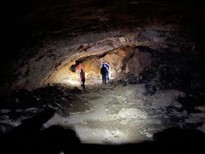
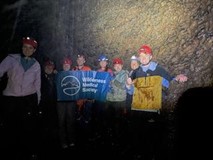
Navigating a cave system. (Photographer: Dr. Stephanie Lareau)
The next part of the elective involved winter and snow related wilderness medicine topics after traveling to Canaan Valley, West Virginia. During the travel day, residents were free to make stops, so two of us stopped at Snowshoe Resort to snowboard before making our way to the group house. The day ended with an interesting lecture about snake envenomation. The next day started with moderate natural snowfall, which led nicely into our discussions regarding hypothermia and frostbite. We then practiced patient extrications and scenarios in areas of fresh snow and learned how to use a litter and various other tools – including tarps and blankets – to provide care for hypothermic patients. After the lessons and scenarios of the day, we took advantage of the few hours of sunlight left and went on a beautiful snow-covered hike to a viewpoint that showed spectacular views of the Canaan Valley. The next day we had a break day, and we all ventured to Timberline Mountain Resort to spend the day snowboarding and skiing.
The last day in West Virginia involved a trip to Canaan Valley Ski Resort where we worked with the ski patrol and learned about avalanches and avalanche rescues, ski injuries, patient extrications, and transport of injured patients. We ended the day with scenarios that encompassed all of the topics we had learned, including hypothermia and ski injuries, and practiced patient extrications in ski litters. Throughout the day, we also practiced mountaineering skills that involved locating patients in the snow after an avalanche. The next day involved travel to Pilot Mountain and another short stop at Snowshoe for snowboarding.
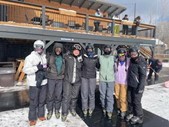
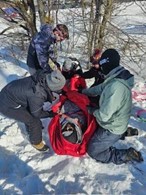
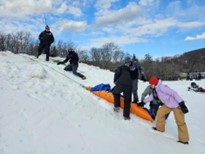
Simulating snow rescues and a snowboarding trip (Photographer: Dr. TJ Malik)
At Pilot Mountain, residents met up with the medical students who were completing the month-long elective. Our first day in Pilot Mountain started with learning rope skills and discussions regarding climbing injuries. We then ventured to Pilot Mountain State Park and practiced rock climbing, rope skills, and rappelling. The day ended with practicing rope rescues on trees. The next day was a joint venture with the medical students and residents; we practiced patient extrications with litters in mountainous terrain at Hanging Rock State Park and then assembled our own medical response backpacks. We finished the day with a large night simulation that involved multiple rescue groups, patients with varying injuries, and an incident commander that conducted the rescue response. We were separated into groups, and each medical student and resident had a role in the rescues. Groups of searchers were sent out first to locate the patients and then groups of medical responders assessed the patients and provided medical treatment. We then coordinated the simulated transport of these patients, and all of them were rescued successfully!
The last full day involved another trip to Pilot Mountain State Park where we learned more rappelling and rope rescues, including how to attach and lift a litter with ropes and anchors down a cliff for patient rescue. We each tried different roles, including managing the anchors and ropes, acting as the litter attending that repels down with the litter, as the medical lead personnel, as the safety inspector, and as the team incident commander. We practiced various angle and rope rescues and rappelled down a 70-foot cliff! The final scenario involved a simulated injured hiker that fell; a rescue team rappelled down to assess the patient while also securing the patient into a litter so that they could be lifted back to the top of the cliff with the litter attendant. This concluded our day at Pilot Mountain State Park, and we returned home for a discussion about wildland fires. The next day included lectures to complete the required topics and farewells to the medical students leaving that day. The residents then had a nice afternoon hiking at Hanging Rock State Park and then one final dinner together in Winston-Salem. The next morning was sad, but we reflected on all of our adventures over the past two weeks and went our separate ways to go back home.
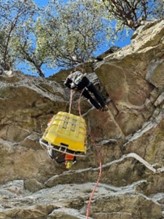
Simulating cliff rescues (Photographer: Dr. Janel Matthews)
The resident elective was a great experience that exposed us to many new wilderness medicine topics. We partook in new activities and great friendships were made. A special bond developed between all of us, and we felt like a family. We plan on staying in contact with each other and hopefully we will be able to partake in more wilderness adventures together in the future.